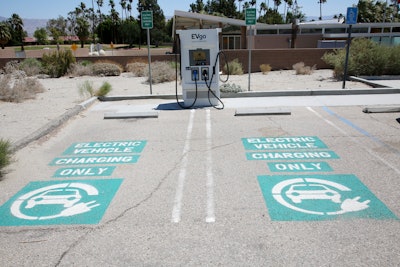
As electric vehicle (EV) sales continue to grow, a key element of successful implementation and adoption is a network of public charging stations readily available to consumers. The Bipartisan Infrastructure Law (BIL) makes a transformative investment in electric vehicle charging in U.S. history. The Biden-Harris administration has prioritized a total of $7.5 billion to buildout 500,000 charging stations by 2030 and make EVs accessible to all Americas for both local and long-distance trips.
Of the $7.5 billion the BIL allocates $5 billion over the next five years for the National Electric Vehicle Charging Formula Program, which provides funding to states to create charging station and establish a national network. The funds will be distributed by predetermined formulas, and can be used for the installation, operation and maintenance related to EV infrastructure. Also, under this program, charging stations must be located along Federal Highway Administration designated alternative fuel corridors.
In addition, $2.5 billion will be allocated over five years for a competitive grant program that will support innovate approaches. This is a grant program that aims to strategically deploy publicly accessible EV charging infrastructure along designated corridors. The DOT Secretary, Pete Buttigieg, is authorized to award grants to states, local governments, metropolitan planning organizations and other public entities.
The growth of the EV market has been steadily increasing over the years and states are thinking about how they will handle the demand for charging stations. The Colorado Energy Office (CEO) fast-charging electric vehicle corridors project comprises high-speed charging stations at 34 locations across the state developed in partnership with ChargePoint and site hosts such as local governments, utilities and private companies.Colorado Energy Office
The Colorado Energy Office (CEO) fast-charging electric vehicle corridors project comprises high-speed charging stations at 34 locations across the state developed in partnership with ChargePoint and site hosts such as local governments, utilities and private companies.Colorado Energy Office
“It’s not just about installing or deploying charging infrastructure, it’s really about the transportation experience," said Andrew Wishnia, deputy assistant secretary for climate policy U.S. Department of Transportation. "We want a convenient, reliable, safe easily accessible system for all users.”
Leading the Charge
Several state departments of transportation are already leading efforts on building out charging infrastructure and laying the groundwork for a national network. Some states are working diligently to keep up, and others are not as focused since the number of EV sales remain a small percentage in comparison to internal combustion engine vehicles. However, states need to be ready when the federal funding from the BIL starts coming in for a network of chargers across the United States. The National Conference of State Legislatures says, at least 47 states offer incentives to support the deployment of EVs or alternative fuel vehicles.
"The DOT brings statewide networks, property, staff together in a way that other government agencies can't," said Michael King, assistant director of energy and electrification, Colorado Department of Transportation."Transportation system data on the infrastructure itself and how, when and where people are traveling that is key when thinking where to site EV charging stations and making those investments."
According to a report by statista California has the most EV charging stations and charging outlets in the United States. While New York ranked second, and Florida ranked third. In January 2021, CA had over five times as many charging outlet as NY. Across the county, the overall number of public charging outlets for EVs was just under 113,600, with the number of chargers continuing to grow with the increase of plug-in EV sales.
It's a collaborative effort between all functions at the state level to execute EV infrastructure implementation. Many state energy offices or organizations are creativing plans specific to their state and communities based on the needs of the residents.
Arkansas and Colorado have developed a statewide grant program for EV charging stations, Hawaii is redirecting gasoline-tax revenue to build new electric infrastructure projects, and New Jersey is requiring EV charging in multi-unit housing, for example.
“State DOTs have the experience with large scale infrastructure build out that other state agencies and local governments are not as familiar with,” said King. “That gives us opportunities to integrate our transportation infrastructure with our power infrastructure and information technology infrastructure in a holistic way as opposed to staying in different silos which could lead to worst results overall.”
Win for Contractors
The influx of federal funding to incentivize the build out of EV infrastructure can lead to additional jobs for the construction industry. The majority of jobs associated with expanded EV infrastructure will fall into technical sectors associated with energy, as well as engineering, planning and construction. These jobs, under the North American Industry Classification System (NAICS) sector 238, specialty trade contractors whose primary activity is performing specific roles involved in building construction or maintenance and repair work. At this time new industry sectors aren’t being defined around EV infrastructure installation, instead jobs are being enhanced by the addition of skill related to the construction of such infrastructure.
Just like anything in construction, EV charging infrastructure won't be built in a day. This type of infrastructure and compound charging stations will require electricians, planners and general contractors. Many of these careers start with a highschool diploma.
Rapid development of EV charging network, coupled with access and education will be required to meet projected demand for charging and promote statewide uptake of EVs. From a workforce development perspective, the skills and knowledge of how to construct a road, parking lot or other facets of hard infrastructure will be useful in building a charging network, consequently creating more jobs in the roadbuilding and construction industry.




















